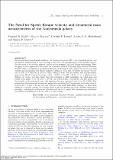Files in this item
The need for speed : escape velocity and dynamical mass measurements of the Andromeda galaxy
Item metadata
| dc.contributor.author | Kafle, Prajwal R. | |
| dc.contributor.author | Sharma, Sanjib | |
| dc.contributor.author | Lewis, Geraint F. | |
| dc.contributor.author | Robotham, Aaron S. G. | |
| dc.contributor.author | Driver, Simon P. | |
| dc.date.accessioned | 2018-01-22T14:30:06Z | |
| dc.date.available | 2018-01-22T14:30:06Z | |
| dc.date.issued | 2018-01-10 | |
| dc.identifier | 252091426 | |
| dc.identifier | 90fd2df6-006b-4923-b9a3-2acb9430d8e1 | |
| dc.identifier | 85044719468 | |
| dc.identifier.citation | Kafle , P R , Sharma , S , Lewis , G F , Robotham , A S G & Driver , S P 2018 , ' The need for speed : escape velocity and dynamical mass measurements of the Andromeda galaxy ' , Monthly Notices of the Royal Astronomical Society . https://doi.org/10.1093/mnras/sty082 | en |
| dc.identifier.issn | 0035-8711 | |
| dc.identifier.other | ArXiv: http://arxiv.org/abs/1801.03949v1 | |
| dc.identifier.uri | https://hdl.handle.net/10023/12568 | |
| dc.description.abstract | Our nearest large cosmological neighbour, the Andromeda galaxy (M31), is a dynamical system, and an accurate measurement of its total mass is central to our understanding of its assembly history, the life-cycles of its satellite galaxies, and its role in shaping the Local Group environment. Here, we apply a novel approach to determine the dynamical mass of M31 using high velocity Planetary Nebulae (PNe), establishing a hierarchical Bayesian model united with a scheme to capture potential outliers and marginalize over tracers unknown distances. With this, we derive the escape velocity run of M31 as a function of galacto-centric distance, with both parametric and non-parametric approaches. We determine the escape velocity of M31 to be 470 ± 40 km s−1 at a galacto-centric distance of 15 kpc, and also, derive the total potential of M31, estimating the virial mass and radius of the galaxy to be 0.8±0.1×1012M⊙ and 240 ± 10 kpc, respectively. Our M31 mass is on the low-side of the measured range, this supports the lower expected mass of the M31-Milky Way system from the timing and momentum arguments, satisfying the H i constraint on circular velocity between 10 ≲ R/ kpc < 35, and agreeing with the stellar mass Tully-Fisher relation. To place these results in a broader context, we compare them to the key predictions of the ΛCDM cosmological paradigm, including the stellar-mass–halo-mass and the dark matter halo concentration–virial mass correlation, and finding it to be an outlier to this relation. | |
| dc.format.extent | 1207146 | |
| dc.language.iso | eng | |
| dc.relation.ispartof | Monthly Notices of the Royal Astronomical Society | en |
| dc.subject | Stars: individual: planetary nebulae | en |
| dc.subject | Galaxies: individual: M31 | en |
| dc.subject | Galaxies: kinematics and dynamics | en |
| dc.subject | Methods: statistical | en |
| dc.subject | QB Astronomy | en |
| dc.subject | QC Physics | en |
| dc.subject | 3rd-DAS | en |
| dc.subject.lcc | QB | en |
| dc.subject.lcc | QC | en |
| dc.title | The need for speed : escape velocity and dynamical mass measurements of the Andromeda galaxy | en |
| dc.type | Journal article | en |
| dc.contributor.institution | University of St Andrews. School of Physics and Astronomy | en |
| dc.identifier.doi | https://doi.org/10.1093/mnras/sty082 | |
| dc.description.status | Peer reviewed | en |
This item appears in the following Collection(s)
Items in the St Andrews Research Repository are protected by copyright, with all rights reserved, unless otherwise indicated.

